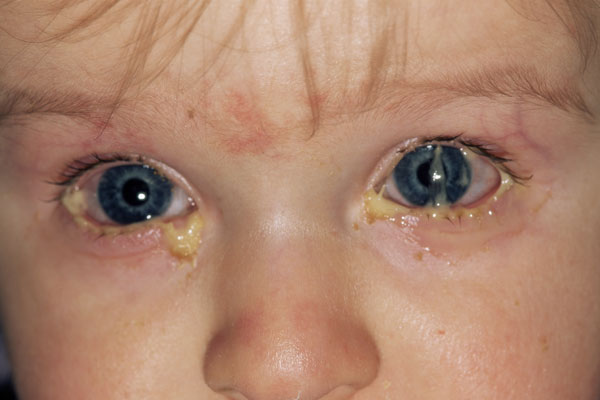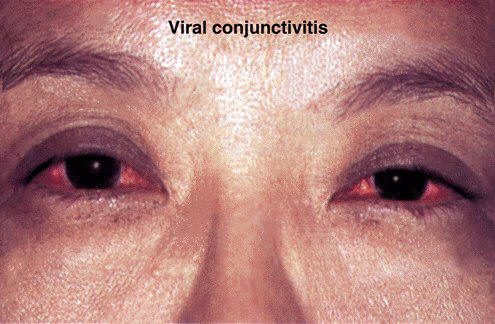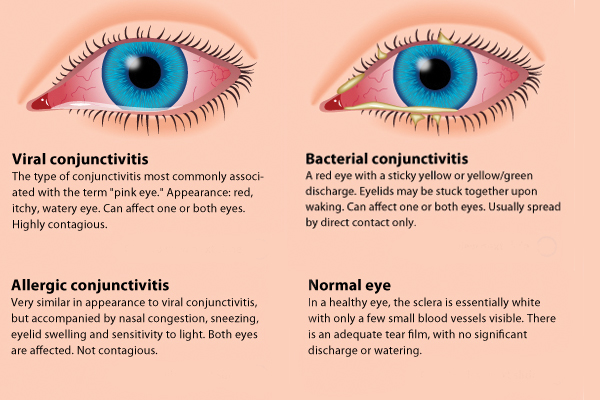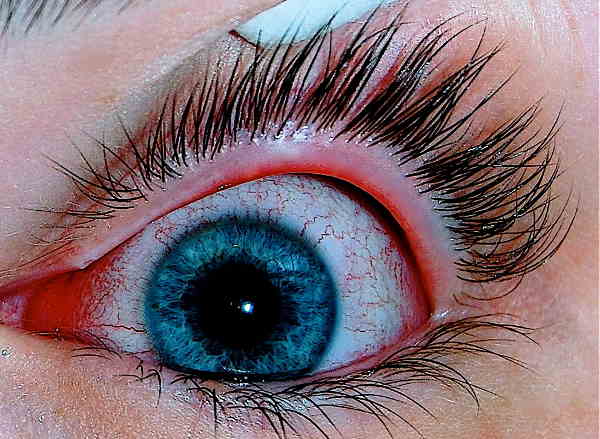Many parents have received that dreaded phone call from a school nurse, teacher, or daycare provider requesting their child be picked up immediately from school due to probable “pink eye”? Though “pink eye” is layperson terminology, it has become synonymous in people’s minds as a highly contagious eye infection. But is this true? This article will review a variety of causes of a pink eye, the differences in presentation of each, appropriate treatment depending on cause, and the likelihood of transmission to another person.
Editor’s Note: The information presented on this website is intended for educational & informational purposes only and is not meant to replace a visit to a qualified healthcare provider.
Not all causes of eye redness are contagious. Not all causes of eye redness require treatment by a medical professional. The following are common causes of eye redness: allergy, viral  infection, bacterial infection, eye injury, rupture of a surface eye blood vessel, eye dryness, environmental irritants, and glaucoma. There are additional causes of eye redness, but these are outside the scope of this article. The reader is referred to ophthalmology textbooks for further information on these.
infection, bacterial infection, eye injury, rupture of a surface eye blood vessel, eye dryness, environmental irritants, and glaucoma. There are additional causes of eye redness, but these are outside the scope of this article. The reader is referred to ophthalmology textbooks for further information on these.
Allergic conjunctivitis can involve one or both eyes, has stringy/stretchy white colored drainage (if any) and often involves swollen eye lids. Some people may even experience very, very small “blisters” near the lashes or on the reverse side of the lid. In this NON-CONTAGIOUS eye ailment, the eyes may be itchy and watery and a person may experience seasonal allergy symptoms at the same time. It involves NO reports of vision changes or pain, and a person may have tan crusting near/around the eyes after sleep. Treatment involves blocking the chemicals of allergic reaction, namely histamines. washing face/hands/hair, eliminating or avoiding allergen, and using anti -histamine eye drops.
-histamine eye drops.
Bacterial conjunctivitis can involve one or both eyes, has yellow or green thick pus like drainage, and the patient may reports the eyes crusted shut when they woke up from sleep. Though irritation, gritty sensation may be reported, there is rarely pain or visual changes. In very young children, it is typically caused by bacteria on the hands introduced to the eye. In older children and adults, the most typical cause is bacteria from the patient’s own sinuses or hands. The primary way that this eye ailment can be spread to another person, is if the pus from the infected eye is introduced into a non-infected eye. From one eye to another in the same person, this can happen quite frequently, but from one person to another, this is much more difficult to accomplish. This is a POTENTIALLY CONTAGIOUS eye ailment. Antibiotic eye drops, as well as the evaluation for and treatment of an underlying sinus infection by a medical professional are recommended. Oftentimes, antibiotic eye drops are prescribed, but a sinus infection remains untreated, which may contribute to a recurrence of eye symptoms once the eye drop is completed. 
Common viral conjunctivitis is VERY CONTAGIOUS. It typically involves both eyes, has watery drainage, and usually precedes a common cold or other viral illness. It may appear that a person is crying, though they are not sad or in pain. Similar to common viral illnesses, this may be spread through infected droplets whether in the air (someone coughs/sneezes) or on surfaces (door knobs, gas pumps). Treatment generally involves comfort measures, as in the case of common viral illnesses this is a self -limited infection and will resolve without medications. Occasionally the inflammation will be so uncomfortable that steroid eye drops may be prescribed. For serious viral infections (ie., Herpes or Cytomegalovirus), oral and/or intravenous medications are used.
-limited infection and will resolve without medications. Occasionally the inflammation will be so uncomfortable that steroid eye drops may be prescribed. For serious viral infections (ie., Herpes or Cytomegalovirus), oral and/or intravenous medications are used.
Eye injuries whether superficial (ie., a scratched cornea or surface blood vessel rupture from coughing) or highly traumatic (ie., foreign body puncturing the eyeball), can cause an eye to become reddened. Typically these involve one eye, but can involve both eyes. Generally the eyes will have increased watery drainage, pain, and visual changes. Obviously, eye injuries are NOT CONTAGIOUS, which is a very good thing!! It is important to have known or suspected eye injuries evaluated by an Ophthalmologist or Optometrist to prevent complications.
With aging and certain diseases (ie., Sjogren’s disease), “dry eye” can contribute to eye redness and a sensation of irritation. Generally there is minimal drainage from the eyes, though there may be an increase of tearing. Typically, no pain or vision changes occur with this scenario. This is a NON-CONTAGIOUS eye redness, that is more often treated with moisturizing eye drops and encouraging increased oral fluids. Though most often harmless, because it may involve older adults, it is important  to evaluate these symptoms, to rule out other age-related conditions requiring medical treatment
to evaluate these symptoms, to rule out other age-related conditions requiring medical treatment
Glaucoma, especially the acute angle variety may have redness, increased tearing, pain and visual changes associated with it. Changes of the iris (colored portion) of the eye may also be present. The cause is an increase of the pressure within the eyeball. It requires immediate evaluation and treatment. If left untreated, it may result in a permanent decrease of vision or blindness. This is a NON-CONTAGIOUS illness. Treatment may involve eye drops to decrease pressure, oral medications, or even surgery.
Various chemicals, cleaners, and smoke found at home, work, neighborhoods, and schools have the potential to cause redness of the eyes. Whether by splashing or through vapor, an actual “burn” of the sensitive eye membranes can occur. The reaction of the body to the toxic substance, causes the eye redness. The eyes may  also having increased tearing, as the body attempts to flush and cleanse the eyeball. This is a NON-CONTAGIOUS situation, that requires immediate relocation of the patient away from the offending substance and generous flushing of the eyes with water or normal saline to decrease potential damage from the chemical. Evaluation of the eyes by an ophthalmologist or Optometrist is important to determine if additional treatment may be needed.
also having increased tearing, as the body attempts to flush and cleanse the eyeball. This is a NON-CONTAGIOUS situation, that requires immediate relocation of the patient away from the offending substance and generous flushing of the eyes with water or normal saline to decrease potential damage from the chemical. Evaluation of the eyes by an ophthalmologist or Optometrist is important to determine if additional treatment may be needed.
For the past 27 years, I have been attempting to educate school nurses, teachers, ancillary medical providers, and PHYSICIANS regarding the use of the term “pink eye”. Almost everyone, when hearing that term, becomes hysterical and adopts near germaphobe behaviors, including extreme handwashing, isolation of the person with symptoms, and environmental saturation with sanitizing cleansers. This article reviewed possible common causes of eye redness, as well as the contagiousness and the treatments associated with each. 


